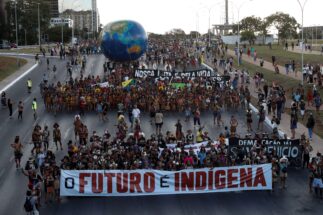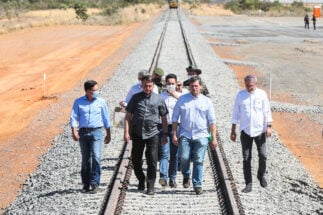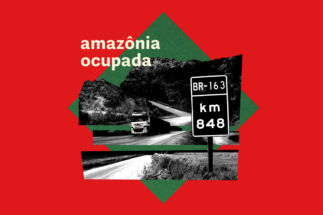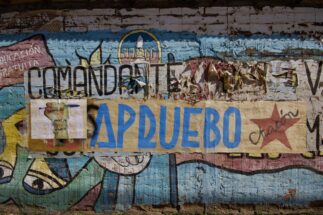Seen from above, the Amazon region reveals two opposing worlds side by side.
On the one hand, dense forest prevents light and sight from penetrating its canopy. Rivers take on unique contours, etching a course and leaving their fingerprints on a forest where many indigenous and riverside communities live among rich vegetation.
On the other side, square parcels of land are carved from the greenery for industrial agriculture, mining operations slash through the forest like scars, miles at a time, while vast herds of cattle speckle the cleared land.
Seen from the sky, a series of fires is quickly turning vast green areas into ashes. They expose a clear imbalance: one of these worlds is advancing, while the other is unable to react.


In recent months, this advance has become increasingly conspicuous to those who follow the changes in the Amazon from above.
“I believe that the upcoming elections, and the lack of certainty over who will be the new president next year, has motivated a rush to destroy the forest,” said Roni Lira, an activist who has been monitoring the biome from the air for more than two decades.
On 26 August, Diálogo Chino accompanied ClimaInfo on a flight over several rapidly advancing deforestation zones in the northern Brazilian state of Pará: the municipalities of Santarém, Belterra, Trairão, Itaituba and Jacareacanga. During the flight, Lira was able to identify changes to the landscape using a mapping system and an experienced naked eye.


“The president, since his speeches pre-election [in 2018], has signalled his encouragement for the devastation of the Amazon for the sake of a ‘development’ that we are yet to see,” said Lira.
Lira added that, in addition to bellicose rhetoric against the protection of the Amazon and traditional peoples, President Jair Bolsonaro has removed officials who investigated environmental crimes, and reduced the budget of the country’s environment ministry – most notably in the control of fires by IBAMA, the ministry’s inspection and enforcement body. Such moves, Lira said, have ensured an “institutional support” to major deforesters.
With polls currently indicating that the Bolsonaro may not be re-elected in October’s presidential election, the destruction of the Amazon is believed to have sped to an even faster rate in recent months – perhaps a last-minute rush. “Since there is no guarantee that, next year, the government will continue this kindness to those who deforest, they are deforesting left, right and centre,” Lira said.


Fires and failing reserve
The humid climate of the Amazon forest prevents fires from occurring naturally, meaning that those that do occur in the region are manmade, generally to clear the forest to make way for various economic activities that have established themselves in the region, such as timber and soy production, cattle farming and mining. Fires tend to multiply after mid-May, when the rainy season comes to a close.
Between May and August this year, a total of 44,338 fire alerts had already been registered in the Amazon, according to data from INPE, Brazil’s national space and atmospheric science institute. This number is the highest for this three-month period during the Bolsonaro administration, with the figure more than double the total alerts in 2018, the year before his inauguration. This August saw the highest number of fires recorded for the month in the past 12 years.
Deforestation also continues to break records, according to INPE data. Estimated annual deforestation jumped from 7,500 km2 in 2018 to 13,000 km2 in 2021 – the largest area deforested in one year since 2006.
Legislation determines that rural landowners in the Brazilian Amazon must protect 80% of native vegetation within their farms, the so-called “legal reserve”. But such rulings on paper do not appear to be matched by mapping from above.

The agricultural frontier continues to advance rapidly in Mato Grosso and Pará – the Amazonian states that have suffered the most deforestation in recent years, and both of which have grown to become more significant hubs for commodities production and distribution. Passing through both states is the BR-163 highway, a road whose construction began in the 1970s, but whose paving was only completed during the Bolsonaro administration. The highway is part of a road corridor that is key for the export of grains, passing through Amazon states to the north of the country.

Illegal mining threats
Pará is also the state where illegal mining is advancing fastest in the Amazon region. Much of this is occurring within indigenous territories, such as that of the Munduruku, where illegal deforestation tripled in 2019 compared to the previous year, and has only expanded since then.
“Mining has been growing very fast in the territory since 2019, when promises [from the president] began that one would be able to mine on indigenous lands,” Alessandra Munduruku, deputy coordinator of the Federation of Indigenous Peoples of Pará, told Diálogo Chino.
Data collected by Lira, based on INPE sources, confirms an explosion in illegal activity during the years of the Bolsonaro administration. In 2018, he reports, 470 hectares of native forest were cleared for mining on indigenous lands in Pará state, a figure that jumped to 2,404 hectares in 2019 and has continued to increase since then. By August, 584 hectares had already been cleared for illegal activity in 2022 – more than the entire year before Bolsonaro’s election.

These developments come at a time when a bill proposed by the president to permit mineral exploration within indigenous territories is still under consideration in congress, but, in practice, it is as if it were already in force, said Alessandra Munduruku: “The bill is not even approved, but the invaders are already there, with huge machines, runways and clandestine aircraft.
“This brings us a lot of suffering. They have wiped out rivers, streams – it’s just mud. There are no more fish, and when there are, they are contaminated by mercury. There are indigenous families buying water, this is happening inside the Amazon.”

The spread and escalation of threats are reflected not only in the destruction of the natural environment, but also of those who live and cover the Amazon region. In July, the tragic murders of indigenous activist Bruno Araújo and British journalist Dom Phillips turned global attention to the region’s destruction.
But this crime was not an exception in Brazil, which ranks fourth among countries where the most environmental activists have been killed, according to a survey by Global Witness. The organisation counts 317 deaths in the last decade – likely an underestimated number.
“We cannot tire of asking for justice for those who fought to defend the country’s environmental policies,” said Auricelia Arapiun, one of the leaders of the ribeirinho communities on the banks of the Tapajós and Arapiuns rivers. “There have been so many deaths, not only of them [Pereira and Phillips]. But they are a symbol of the gravity of the situation we are living today in the Amazon.”

In interviews and speeches, President Bolsonaro continues to insist that Brazil sets an example in the protection of its forests and their peoples. Meanwhile, former president Luiz Inácio Lula da Silva, Bolsonaro’s rival for the October election and the current poll leader, has said he wants to put an end to illegal mining, launch an alliance of countries with tropical forests and create an indigenous ministry to enhance protection.

The candidates’ promises, however, were still met with scepticism among environmentalists consulted by Diálogo Chino, including the Arapiun leader: “I have more expectations in the new congress than in the executive. With more indigenous leaders and traditional populations occupying that space, there is more hope.”









